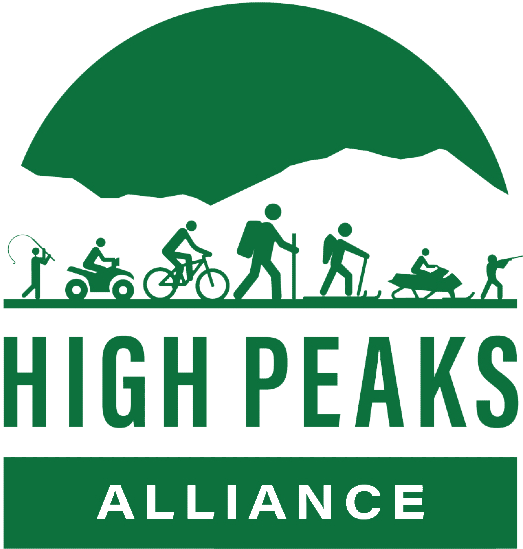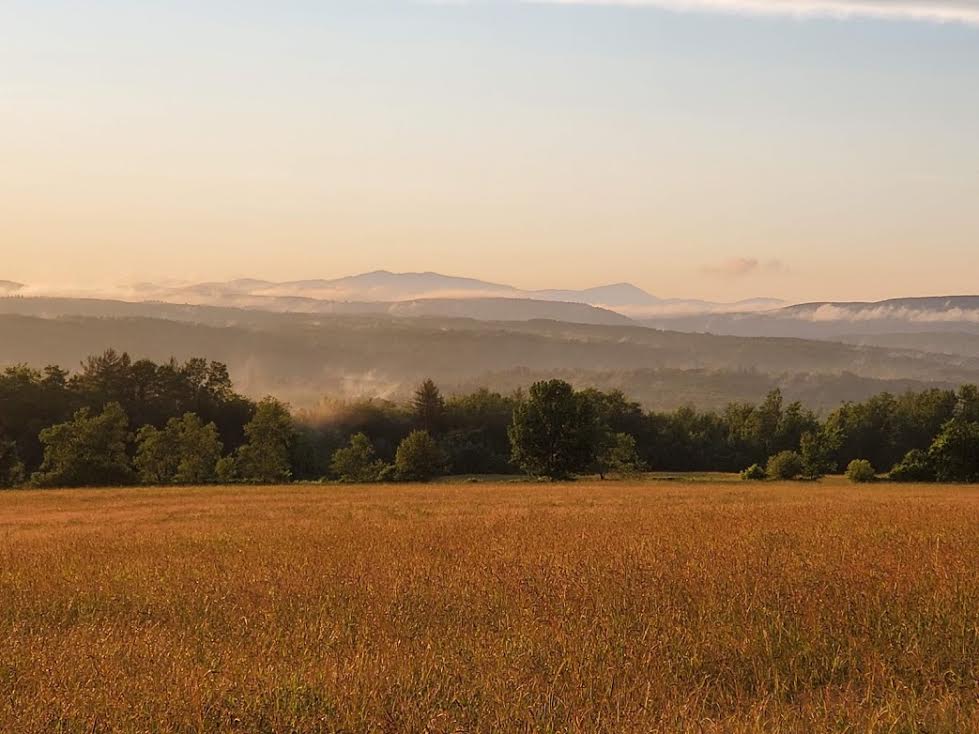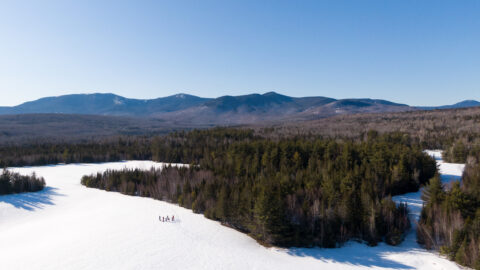Fresh Air Fun: High Peaks region

People that know me understand that I am passionate about the outdoors. I love it all, hunting, fishing, hiking, boating, snowmobiling, ATV’ing, birdwatching and just plain old sightseeing. I also happen to think we live in one of the best regions of the best state in the union- the Sandy River Valley and high peaks beyond. As my friend Scott Landry is fond of saying “we live in the best place on earth.” My goal, and the goal of the High Peaks Alliance (HPA) is to keep it that way. Maine is unique but changing, and the wild places we take for granted are at risk for future generations if we do not act now. Both Scott Landry and I are board members of the High Peaks Alliance, and I took a few minutes this week to interview HPA Executive Director Brent West to learn more about the organization.
Hi Brent, what exactly is the HPA and why is it important for our area?
The High Peaks Alliance believes that people should always have access to the outdoors. We lead the region in conserving land, building and maintaining trails, and connecting people to each other and this landscape. Because when we do, we build stronger communities and more people will desire to live, work, and recreate in this region, thereby bringing economic vitality to us all.
What are the boundaries of the HPA region and why does this region deserve to be preserved?
The core of our service area is focused on the communities that surround the 10 of the 14 tallest mountains in Maine. This includes the gateway community of Farmington stretching all the way to the Canadian border. In this area we have amazing resources like Tumbledown Mountain, the Appalachian Trail, Headwaters to the Kennebec and Androscoggin Rivers, and welcoming communities. I like to talk about conservation not in the sense of saving the past but thinking about what we would like to always have in the future. This philosophy at its core is about access. We can all agree one of the best parts of living here is the freedom to roam the countryside discovering the views and natural wonders of the area. This access to the land allows a very high quality of life. As land is posted and areas gated, we start to lose some of this quality of place. So, our work is to ensure that there will always be places to explore and use, responsibly, for us and for future generations.
People in this region love to use trails for a multitude of purposes, from horse-riding to ATVs to hiking, snowmobiling, and birdwatching. How do you include all those diverse activities when considering a project?
Maine forest’s is what would be defined as a multiple use forest. This means that these forests are used for many things like, forestry, hiking, hunting, motorized trails, wildlife habitat, and some development. Some think that multiple use means allowing every use. That isn’t the case, it is understanding the many different needs of our community and seeing where each of these uses are appropriate. A good example is the Eddy pond crossing of the Appalachian Trail we worked to get in place. This is a official motorized crossing of the AT. The Snowmobile and ATV clubs needed legal access from Rangeley to Madrid but the AT community wanted to protect the wilderness experience of the Trail. Through conversations and getting the ATV club to help haul some bridge material we helped find some middle ground. We found that these two groups both have a deep love of the outdoors and that when they worked to find a fair solution the outcome was positive. There are other projects where sometimes you cannot accommodate all uses because of legal, funding or landowner restrictions. What we have found is more important is that everyone has a voice and that if a use should be accommodated there needs to be a trail club or group of people that are available to manage the use. The High Peaks Alliance is a place where you have this voice and place at the table to be able to make sure what you love to do is part of our shared future.

The benefits to land users is pretty clear. Do you see any benefits to landowners, towns or businesses in the region?
My father is a builder and my mother a real estate agent. Through their lenses it is very clear the benefits of our natural landscape and trails to our community. The majority of both of their business has been people moving here to be in a place rich with access and natural resources. In Franklin county, over a third of the housing units are recreational and seasonal homes. My mother has a constant stream of prospective buyers looking for direct trail access which means if you let a trail on your property, it will make your land more marketable. You will have a group of committed neighbors and friends through your local club that will take care and monitor your property. The towns get increased tax base because of these homeowners. I always ask businesses to also think about what their employees do on the weekends. They use trails, camp, hunt, fish and explore. The conservation of land makes sure that they will always be able to unwind on the weekends. The Knight foundation found in a study that attachment to place is the best indicator of economic strength and that attachment was driven by three things. These were the availability of open spaces and trails, the community’s openness to new ideas and people, and social offerings.
Tell me about Shiloh pond in Kingfield? What was accomplished and what are the benefits to the public from that success story?
This new 215-acre forest, now owned by the Town of Kingfield, will protect Shiloh Pond, a popular fly-fishing gem in Western Maine and will protect a wilderness experience just two miles from the center of Kingfield. After the property was listed for sale in 2018, residents of the Town of Kingfield rallied to take action to protect the land. The Town worked in partnership with The Trust for Public Land and High Peaks Alliance to acquire the property in order to permanently protect Shiloh Pond and surrounding wetlands, streams and woods, while creating an outdoor gathering space for the entire community. HPA and TPL raised $550,000 for this project to purchase the land, cover all of the transaction costs and have some funding left over for the start up costs of maintaining the property.
The Kingfield Community Forest will preserve the pristine 19-acre Shiloh Pond, nearly 30 acres of wetlands, high value Inland wading bird and waterfowl habitat, and old-growth type forest which is increasingly rare in the State of Maine. The pond and surrounding woods will offer numerous ways for neighbors and visitors to enjoy the outdoors including fly-fishing and paddling, while allowing for additional hiking, biking and skiing trails to be constructed.
As a community forest, the land will be collectively owned and managed by the Kingfield community. Residents will have direct input into the management of the land and implementation of trails and activities. The implementation of the community’s vision for the land will be supported by the High Peaks Alliance.
Any other big projects on the horizon?
One project I am especially excited for is working with UMF to start building accessible trails from Front street to the Sandy River in Farmington. These will be the first accessible trails in the entire county. We have heard again and again that this area lacks accessible features. Over 40 percent of Franklin county is disabled, elderly, or young children. This trail will allow these families a place to connect to nature and not be left out anymore. This trail will be a compacted crush stone surface that will be popular for many people. River trails like this that connect directly to campus and the downtown will also give people a reason to visit town. They will stay longer in town which also will lead to more shopping and eating out. We just received word that this project was approved for $50,000 from the Northern Forest Center. This will match the $46,000 already committed. As we build this trail, we hope that the community will reach out as we hope to keep improving access for all people.
How can people get involved?
The first step would be to become a member. You will get our newsletter that makes sure you know everything that is coming down the pipeline. It also makes sure you have a voice in the many conservation projects that are happening in our area. You can do this by going to https://highpeaksalliance.org/become-a-member/. It is because of our members that any of these projects are possible because we have been able support my time to be able to work on these important projects. There is also a volunteer form on the website if you would like to put some of your time into projects like these. We have many more projects happening like the Fly Rod Crosby Trail, Trails in Strong, Kingfield Community forest, Farmington Accessible trails, and numerous land conservation projects with the partners of the High Peaks Initiative.
Any parting words?
This area of Maine is the frontline of the Maine North Woods. We have best of both worlds with tight knit communities in southern Franklin county and wild expanses in the woods north of the mountains. In the last 20 years so much of this land has changes hands from lumber companies and families to investors and kingdom lot owners. Last year alone real estate prices skyrocketed 30 percent in Franklin county, which was the highest in the state. The effects of these changes are starting to show. We hear of trail closures, posted signs, gates. This trend will only continue but I see a region if we come together and form this Alliance that we could build an absolute outdoor paradise. If we continue to grow with support of our community, we will have places to recreate, visit, and take our grandkids. We welcome those who would set aside differences to work together to ensure public access for present and future generations in the High Peaks region.

This concludes my interview with Brent West, the Executive Director of the High Peaks Alliance. I would like to emphasize two points from the interview. Inclusivity means attempting to accommodate people of all abilities and recreational preferences, and the economic benefits to our business communities are directly tied to people frequenting the available outdoors resources. The value to people for both mental health and economic reasons are important now and will be more so into the future. If you value this now and wish to preserve this land legacy you may want to join the HPA as a member.
Darryl Wood lives along the Sandy River in New Sharon with his wife Becky. He enjoys just about every outdoor pursuit, and appreciates the opportunity to share experiences about our great region of Maine. If you have suggestions for topics, or would like to reach him, he may be reached at [email protected] or 207-491-5983.
This article was originally published here:




